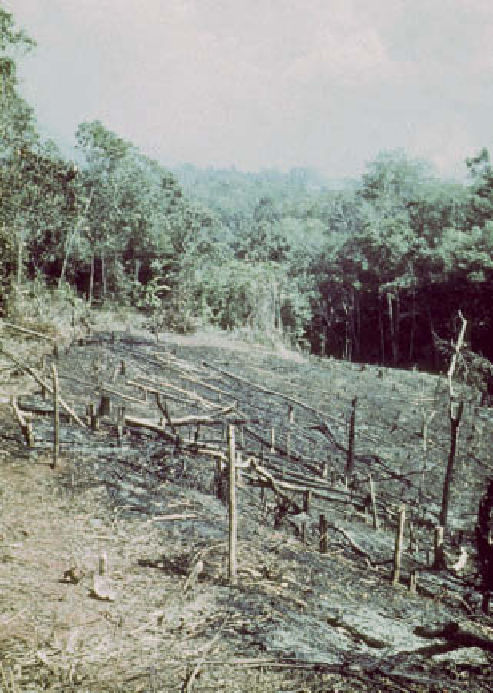Geoscience Reference
In-Depth Information
to extract ions from dilute solutions such as soil water.
The fungus thus acts as a nutrient pump for the tree,
and is especially important to tropical trees because
they are on old ferralitic soils (i.e. heavily leached soils
with a low cation exchange capacity). Indeed, so
integrated and refined is this mycorrhizal relationship
that the fungi are often in direct contact with organic
litter and can transfer nutrients from it direct to the
roots.
5
The physiology of tropical trees, especially their root
systems, is such that they have the ability to pump large
volumes of water from the soil, 'filtering' it for nutrients
as they do so.
Nutrient cycles within the rain forest are radically
altered by human clearance for agriculture. The traditional
peasant system is that of shifting cultivation, whereby a
patch of forest is burned on a rotation basis (
Plate 21.4
).
Crops are cultivated for several years in the burned area,
until it is abandoned, allowing the forest to reinvade.
The patch may be reused on a twenty- to thirty-year
rotation. The essence of this 'slash and burn' system is
that the nutrients in the biomass are quickly released into
the soil and litter compartments of the cycle. Harvesting
of the crops then takes nutrients, as well as energy, out of
the system. Even if fertilizers are added, the effects are
temporary, and cropping of the patch becomes unsus-
tainable after a few years. These traditional indigenous
technologies are well adapted to their local environment
unless disturbed by rapid population growth, economic
exploitation, or imposed land tenure changes. However,
pressure from one or more of these three factors converts
a simple yet sustainable practice, generally in sympathy
with the ecosystem, into an unsustainable and inappro-
priate alien technology.
Tropical forests are frequently replaced by plantation
crops (oil palm, rubber, cacao, coffee, tea, sisal) (
Plate
nutrients within the cycle. Stem flow is accelerated, and
management techniques like weeding increase surface
run-off. This, in conjunction with harvesting, leads to
large losses of nutrients. The biomass and soil stores are
likely to hold the bulk of the nutrients. The net result of
both shifting cultivation and plantation agriculture is to
drastically alter nutrient cycles from a fundamentally
stable natural system, comprising a diverse complexity of
components where every niche is filled in order to
maximize efficiency, to an unstable condition where there
are few components or, in the case of the plantation, just
one. The human objective is to harvest nutrients with a
minimum of inputs. Inevitably, where such land use
Plate 21.4
A 'swidden' or burnt patch made by shifting
cultivators in tropical rain forest in Sarawak. Crops benefit
maligned but is in sympathy with the ecosystem.
Photo: Michael Wilson
systems expand in their coverage within the tropical rain
forest zone, the entire ecosystem becomes unstable.
The interaction between the phosphorus and carbon
cycles in tropical rain forests is of interest because of
the potential response of tree growth to increasing
levels of atmospheric carbon dioxide. Will the relative
unavailability of phosphorus be a constraint on enhanced
growth and hence on carbon sequestration in tropical
forests? Recent investigations suggest that plants may be
better able to acquire phosphorus from nutrient-poor
Amazonian soils (Phillips
et al
. 1998). There are three
important interactions:
1
Mycorrhizal associations are expensive in terms of
energy (i.e. carbon) requirements, therefore increased
carbon dioxide will enhance mycorrhizal colonization
and therefore help overcome P limitations.










































